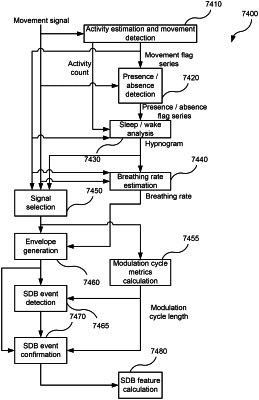| CPC A61B 5/7275 (2013.01) [A61B 5/08 (2013.01); A61B 5/103 (2013.01); A61B 5/113 (2013.01); A61B 5/4818 (2013.01); A61B 5/7221 (2013.01); A61B 5/7264 (2013.01); A61B 5/742 (2013.01); A61B 5/746 (2013.01); G08B 21/02 (2013.01); G16H 40/63 (2018.01); G16H 50/20 (2018.01); A61B 5/0507 (2013.01); A61B 5/087 (2013.01); A61B 5/0816 (2013.01); A61B 5/097 (2013.01); A61B 5/1115 (2013.01); A61B 5/1118 (2013.01); A61B 5/1126 (2013.01); A61B 5/4809 (2013.01); A61B 5/7246 (2013.01); G16H 50/30 (2018.01)] | 25 Claims |

|
1. A monitoring apparatus comprising:
a contactless motion sensor configured to generate one or more movement signals representing bodily movement of a patient during a monitoring session;
a processor; and
a memory storing program instructions configured to cause the processor to carry out a method of processing the one or more movement signals, the method comprising:
selecting one or more epochs of the one or more movement signals during which the patient was asleep and not performing gross bodily movements by extracting one or more waveform length values from one or more epochs of the one or more movement signals and identifying one or more epochs in which an extracted waveform length value is less than a threshold;
extracting one or more sleep disordered breathing (SDB) features from the one or more selected epochs of the one or more movement signals; and
predicting whether a clinical event is likely to occur during a predetermined prediction horizon based on the one or more SDB features.
|